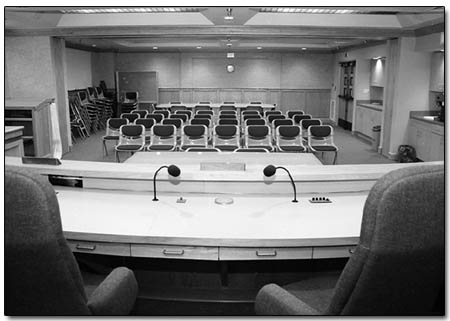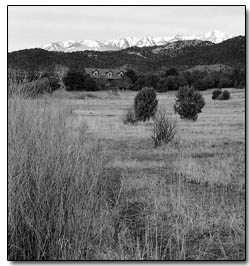 |
| Anyone out there? La Plata County commissioner
chambers, the sight of many a contentious debate over the
years, have been a little quiet as of late, according to
at least one county official. |
Lately, several calls of “where are
the people” have sounded through meeting rooms throughout
the basin. And while local activism may appear to be on the
wane, opinions from planners, activists and officials run the
full spectrum. Many believe it’s as strong as ever and
just refocusing, while others think we’re seeing an unfortunate
trend during a critical time in Durango’s history.
Perhaps the biggest current blip on the Durango radar screen
is development in the Grandview area. As proposed by the Southern
Ute Indian Tribe and the Crader family, up to 2,000 new dwelling
units would take the place of 920 acres of open space roughly
two miles east of Durango. As an incentive, the group has offered
to donate 35 acres to accommodate the overcrowded Mercy Medical
Center for a new facility. And somewhat surprisingly, considering
its seemingly huge density, the project largely has drawn public
praise.
 Most
ironic, however, is that the same parcel was proposed for development
in 1994. The California proponents were not pushing for thousands
of units but a mere 250 on the land that became known as the
Artesian Valley Ranch. After three years of heated meetings
and solid opposition, La Plata County commissioners eventually
approved the plan. However, not a single unit was ever built.
In addition, up to 2,000 new units in the Grandview area are
not alone in terms of proposed development around Durango’s
borders. The Kroeger Ranch and Ewing Mesa developments would
throw another 2,800 units into the mix, making for a near doubling
of Durango over the next 20 years. However, Durango residents
have largely been silent about these changes.
Most
ironic, however, is that the same parcel was proposed for development
in 1994. The California proponents were not pushing for thousands
of units but a mere 250 on the land that became known as the
Artesian Valley Ranch. After three years of heated meetings
and solid opposition, La Plata County commissioners eventually
approved the plan. However, not a single unit was ever built.
In addition, up to 2,000 new units in the Grandview area are
not alone in terms of proposed development around Durango’s
borders. The Kroeger Ranch and Ewing Mesa developments would
throw another 2,800 units into the mix, making for a near doubling
of Durango over the next 20 years. However, Durango residents
have largely been silent about these changes.
In a similar fashion, Durango’s new Home Depot has turned
from a grassy lot to one of the largest warehouses in the county
in recent months. Aside from a few jabs in these pages, the
hardware warehouse’s construction has gone seemingly unnoticed
or been embraced with comments like “at least I won’t
have to drive to Farmington anymore.”
However, in 1996, many Durangoans again turned out in force
to oppose the construction of Wal-Mart. Again meeting rooms
were filled and tempers flared as people opposed a business
they felt would damage the character of Durango.
Right where it should be
In spite of these examples and others, Durango Planner Greg
Hoch said he doesn’t believe local residents have changed
that much and that activism is right where it should be in the
city. “I don’t believe activism is on the wane,”
he said.
Addressing Home Depot’s coast to final construction,
he noted, “I think Wal-Mart was a watershed battle. Wal-Mart
was seen as a town changer and a town killer. Home Depot’s
not seen as something that kills your moms and pops. In fact,
people see it as something that stimulates competition.”
Speaking of Grandview, Hoch said that the dynamic of the project
has changed, making it more favorable to the community. “Grandview
was a very contentious project in the county in the 1990s with
considerably fewer units, but it was more sprawl oriented with
large lots,” he said. “I think the scale has changed
considerably, but from what I gather, people also regard the
hospital as a good neighbor.”
Hoch also suggested that attendance at public hearings may
be down because government in Durango is doing a good job. “I
think some people stop being active when they have a confidence
level that projects are going to turn out right,” he said.
“In this town, you often have a large number of people
who support projects, but they don’t show up to meetings.”
He also added that a great deal of public input is going beyond
complaining and into projects aimed at improving Durango life,
like the dark skies effort.
 Right
where it’s never been
Right
where it’s never been
Joe Crain, director of La Plata County Planning Services, has
a somewhat different perspective. Crain said he’s noticed
diminished public participation on county issues, particularly
the smaller ones.
“I’ve noticed over the last couple of years, that
unless something’s going on in someone’s neighborhood,
participation is kind of light,” he said. “Maybe
it’s because people are having to work harder and don’t
have time.”
As an example, Crain cited a recent meeting on expanding on
the future of commercial business on East Animas Road, County
Road 250. A storage unit complex’s desire to expand spurred
the meeting, which eventually became a discussion and planning
session for commercial use as a whole on the road. Crain said
he was most surprised at the low attendance because East Animas
Road is one of the only places in La Plata County that has set
strict zoning and rigorous development standards.
“The whole intent of the meeting was to discuss commercial
uses in the valley,” Crain said. “I was kind of
surprised that we didn’t have more people show up. It
seems like unless there’s a major project that’s
objectionable and coming in right next to you, it’s difficult
to get people to show up. The participation level is just not
what it used to be.”
Having been directly involved in the controversy surrounding
the Artesian Valley Ranch, Crain said he’s been surprised
by the lack of controversy surrounding the Grandview proposal,
but he also attributes much of it to the hospital. “I’m
amazed at what’s happened, but I think a lot of the Grandview
situation is because of the hospital itself,” he said.
He added that he finds the lack of public involvement particularly
disturbing given the amount of development that is currently
proposed for La Plata County and Durango. “I wish somebody
could tell me why the interest has waned,” he said. “As
we move toward the future, we’re going to face pressures
we’ve never faced before. The next few years are going
to be instrumental for the future of the county.”
However, Crain also noted that a hand-picked, public group
is currently working on transferable development rights with
great success as are other groups. “That group has been
exceptional with their attendance and interest,” he said.
He also acknowledged that the Durango Mountain Resort expansion
drew a great deal of public involvement.
Keeping issues in focus
Colorado Wild Executive Director Jeff Berman was at the forefront
of the controversy surrounding the DMR expansion. While he said
that the current technical analysis of master improvement plans
has not drawn much public interest, activism on the project
is still strong.
“In reference to DMR, the initial application of the
master conceptual plan was a key component and naturally, there
was a lot of public involvement with that,” he said. “I
don’t expect too much public involvement with the master
improvement plans. Theyhighly technical in nature.”
However, as planners move into the analysis of the village
conceptual plans, which will lay out fairly concrete sketches
of what is planned for construction at the resort, Berman said
he expects the expansion to return to the forefront. “I
expect a great deal of public input,” he said.
Mark Pearson, executive director of San Juan Citizens’
Alliance, also said he believes that the public is still passionate
about the hard issues. However, he added that there may be a
fixed amount of energy that’s being focused in different
places.
“Certainly, there’s still the same amount of energy,
but maybe it’s focused in different places now,”
he said, noting that Kroeger Ranch, Ewing Mesa and Grandview
have been particularly quiet.
One of those different places has been oil and gas, according
to Pearson. “In terms of oil and gas issues, business
has never been better for us,” he said, relating a Durango
hearing where 200 people showed up to comment on gas wells proposed
for the Farmington area.
With respect to new development, Pearson said that the patina
of New Urbanism, as a solve-all for growth woes, also may be
keeping people satisfied. “All of these mega-developments
are touting themselves as visionary, new-age, 21st century projects,”
he said. “They’re all speaking a much different
lingo.”
Like Hoch and Crain, Pearson said he sees people putting positive
energy into the community, citing efforts to relocate the library
and Children’s Museum as two examples. “There’s
a lot of energy focused on proactive projects that are improving
the community,” he said.
A time for every issue
Clearly, the amount of public participation and activism is
a matter of opinion, Regardless of how you weigh it, everyone
seems to agree that a good litmus test for local activism will
be the forthcoming revision of the county’s land-use codes.
The county is attempting to take regulations that have been
called “the worst of all worlds” and make them a
modern, effective guiding document.
The process will demand public input in order to be effective.
“With the code changes, we’re going to be trying
really hard to get people without vested interests to comment,”
said County Planner Nancy Lauro.
Pearson said, “What might be most telling is how many
people get involved
in the county’s land-use revisions.” However,
Hoch noted that that decision rests in the public’s hands.
Whether the land-use revision becomes the hot issue of the day
depends on the whim of the community. “Participation just
depends on particular issues coming up at particular times,”
Hoch said.

